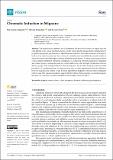Chromatic induction in migraine
Abstract
The human visual system is not a colorimeter. The perceived colour of a region does not only depend on its colour spectrum, but also on the colour spectra and geometric arrangement of neighbouring regions, a phenomenon called chromatic induction. Chromatic induction is thought to be driven by lateral interactions: the activity of a central neuron is modified by stimuli outside its classical receptive field through excitatory–inhibitory mechanisms. As there is growing evidence of an excitation/inhibition imbalance in migraine, we compared chromatic induction in migraine and control groups. As hypothesised, we found a difference in the strength of induction between the two groups, with stronger induction effects in migraine. On the other hand, given the increased prevalence of visual phenomena in migraine with aura, we also hypothesised that the difference between migraine and control would be more important in migraine with aura than in migraine without aura. Our experiments did not support this hypothesis. Taken together, our results suggest a link between excitation/inhibition imbalance and increased induction effects.
Citation
Cerda-Company , X , Penacchio , O & Otazu , X 2021 , ' Chromatic induction in migraine ' , Vision , vol. 5 , no. 3 , 37 . https://doi.org/10.3390/vision5030037
Publication
Vision
Status
Peer reviewed
ISSN
2411-5150Type
Journal article
Description
Funding: This work is partially supported by the Spanish Ministerio de Economía, Industria y Competitividad, Gobierno de España through research project DPI2017-89867-C2-1-R, by the Agen- cia de Gestió d’Ajuts Universitaris i de Recerca (AGAUR) through 2017-SGR-649, and CERCA Programme/Generalitat de Catalunya.Collections
Items in the St Andrews Research Repository are protected by copyright, with all rights reserved, unless otherwise indicated.

